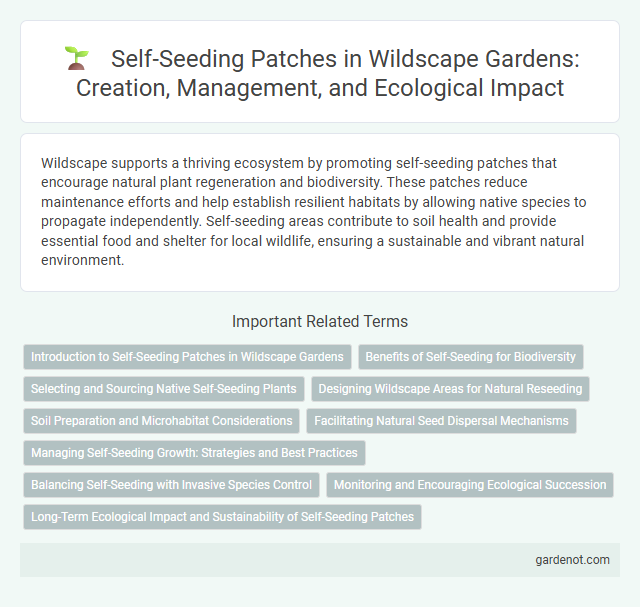Wildscape supports a thriving ecosystem by promoting self-seeding patches that encourage natural plant regeneration and biodiversity. These patches reduce maintenance efforts and help establish resilient habitats by allowing native species to propagate independently. Self-seeding areas contribute to soil health and provide essential food and shelter for local wildlife, ensuring a sustainable and vibrant natural environment.
Introduction to Self-Seeding Patches in Wildscape Gardens
Self-seeding patches in Wildscape gardens naturally propagate plants by dispersing seeds directly into the soil, promoting biodiversity and resilience. These patches support native flora regeneration, requiring minimal maintenance while enhancing habitat complexity for local wildlife. Integrating self-seeding areas encourages ecological balance and sustainable gardening practices within the Wildscape environment.
Benefits of Self-Seeding for Biodiversity
Self-seeding patches enhance biodiversity by facilitating natural plant regeneration, which supports diverse insect and wildlife habitats. This process reduces the need for manual reseeding and chemical inputs, promoting ecological resilience and soil health. As self-seeding plants establish, they create microhabitats that sustain pollinators and other beneficial species crucial for ecosystem balance.
Selecting and Sourcing Native Self-Seeding Plants
Selecting native self-seeding plants for a wildscape improves ecological balance by supporting local pollinators and wildlife. Sourcing species like Echinacea purpurea, Rudbeckia hirta, and Asclepias tuberosa from reputable native plant nurseries ensures genetic suitability and enhances long-term habitat sustainability. Proper identification of region-specific flora promotes natural regeneration and reduces maintenance needs within the self-seeding patch.
Designing Wildscape Areas for Natural Reseeding
Designing wildscape areas for natural reseeding involves selecting diverse native plant species that produce prolific seed sets suited to local soil and climate conditions. Incorporating varied microhabitats such as open sunny patches, shaded zones, and disturbed soils encourages seed germination and growth across different species. Strategic placement of self-seeding patches supports ecological succession, enhances biodiversity, and reduces maintenance by enabling natural plant regeneration.
Soil Preparation and Microhabitat Considerations
Effective soil preparation for a self-seeding patch involves loosening the topsoil to a depth of at least 15 centimeters to enhance seed-to-soil contact and moisture retention. Incorporating organic matter such as compost improves soil structure and nutrient availability, fostering optimal microhabitat conditions for seed germination. Creating microhabitats by maintaining varied leaf litter and small bare soil patches supports biodiversity and provides shelter for emerging seedlings and beneficial invertebrates.
Facilitating Natural Seed Dispersal Mechanisms
Self-seeding patches in wildscapes enhance biodiversity by facilitating natural seed dispersal mechanisms such as wind, water, and animal activity. These patches create microhabitats that support native flora regeneration and promote genetic diversity through localized seed spread. Encouraging self-seeding reduces the need for manual planting, fostering resilient ecosystems that adapt organically over time.
Managing Self-Seeding Growth: Strategies and Best Practices
Managing self-seeding growth in wildscape environments requires regular monitoring to balance natural propagation with landscape design goals. Implementing selective thinning and targeted removal of excessive seedlings prevents invasive spread and maintains biodiversity. Utilizing native species with strong ecological benefits supports sustainable growth while enhancing habitat resilience.
Balancing Self-Seeding with Invasive Species Control
Effective self-seeding patches in wildscapes promote native biodiversity by allowing desirable plants to naturally regenerate without extensive human intervention. Balancing self-seeding requires vigilant monitoring to prevent invasive species from outcompeting native flora, which can disrupt ecosystem stability. Employing targeted removal techniques and selective planting enhances the resilience of self-seeding patches while maintaining ecological harmony.
Monitoring and Encouraging Ecological Succession
Monitoring self-seeding patches in Wildscape is crucial for tracking natural regeneration and biodiversity growth. Encouraging ecological succession involves minimal intervention to allow native species to establish and mature, enhancing habitat complexity over time. Regular assessments of species composition and soil health guide adaptive management to support long-term ecosystem resilience.
Long-Term Ecological Impact and Sustainability of Self-Seeding Patches
Self-seeding patches contribute to long-term ecological impact by promoting native biodiversity and enhancing habitat resilience through natural regeneration processes. These patches reduce the need for external inputs such as seeds or fertilizers, supporting sustainability by maintaining soil health and fostering adaptive plant communities. Over time, self-seeding areas stabilize local ecosystems, increase carbon sequestration, and provide continuous habitat connectivity essential for wildlife conservation.
Self-seeding patch Infographic

 gardenot.com
gardenot.com